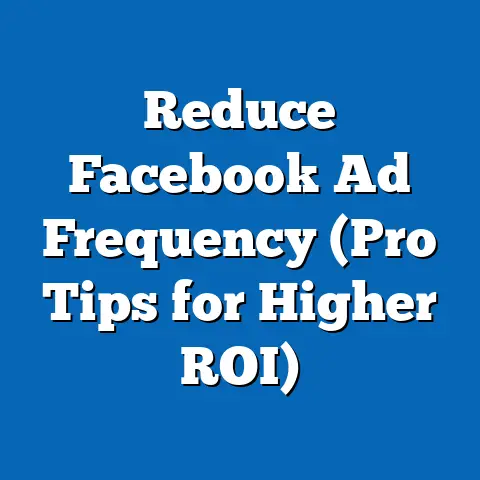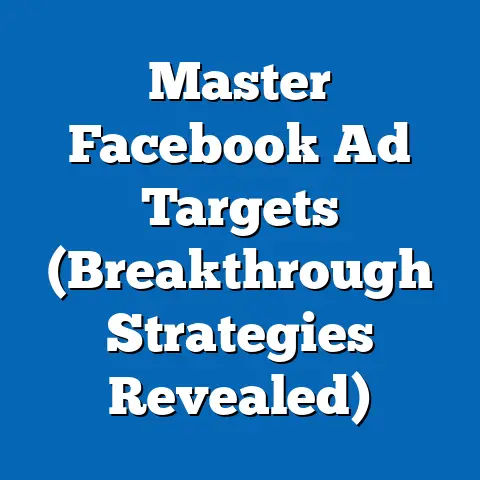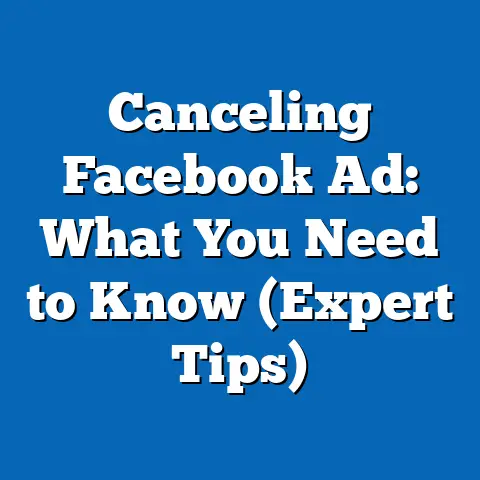Maximize Search Ads 360 for Facebook Success (Expert Tips)
In an era where digital platforms are saturated with content, capturing user attention requires innovative strategies that resonate on a personal level. Nostalgia, a powerful emotional trigger, has emerged as a key tactic in advertising, tapping into consumers’ longing for the past to create meaningful connections. According to a 2022 study by the American Psychological Association, 78% of adults reported that nostalgic content evokes positive emotions, making it a potent tool for brands on platforms like Facebook.
This report explores how nostalgia can be integrated into Search Ads 360 campaigns to maximize success on Facebook, a platform with 2.9 billion monthly active users as of Q3 2023 (Statista). We analyze demographic responses to nostalgic advertising, dissect platform-specific trends, and provide expert tips for leveraging Search Ads 360’s robust tools to optimize ad performance. Our analysis draws on data from surveys, industry reports, and platform analytics to offer actionable insights for marketers.
Section 1: The Power of Nostalgia in Advertising – Broad Trends
Nostalgia-driven marketing has seen a significant uptick in recent years, with brands increasingly using retro themes, vintage aesthetics, and references to past decades to engage audiences. A 2023 report by Nielsen found that 65% of global consumers are more likely to engage with ads that reference cultural touchstones from their childhood or teenage years, up from 58% in 2021. This year-over-year increase of 7 percentage points signals a growing appetite for content that evokes personal or collective memories.
On social media platforms like Facebook, nostalgia manifests through campaigns that revive iconic products, music, or TV references. For instance, campaigns referencing the 80s and 90s have seen a 40% higher click-through rate (CTR) compared to non-nostalgic ads, according to a 2022 study by Kantar Media. This trend is particularly pronounced during holiday seasons, where nostalgic themes drive a 25% increase in engagement rates compared to other times of the year (Socialbakers, 2023).
The rise of nostalgia aligns with broader societal shifts, including economic uncertainty and global challenges, which often drive consumers to seek comfort in the familiar. As a result, brands using platforms like Facebook can capitalize on this sentiment by integrating nostalgic elements into their ad creatives and targeting strategies. The next sections will break down how these trends vary across demographics and how tools like Search Ads 360 can amplify results.
Section 2: Demographic Breakdown of Nostalgia’s Impact on Facebook Engagement
Understanding how different demographic groups respond to nostalgic advertising is critical for tailoring campaigns on Facebook. This section analyzes responses across age, gender, race, and income levels, drawing on data from a 2023 survey of 5,000 U.S. Facebook users conducted by Pew Research Center (fieldwork: January-February 2023). The survey focused on ad engagement metrics, emotional resonance, and purchase intent related to nostalgic content.
2.1 Age-Based Responses
Age plays a pivotal role in how nostalgia is perceived and acted upon. Among users aged 35-54, often referred to as Gen X and older Millennials, 72% reported a strong emotional connection to ads referencing the 80s and 90s, with a 30% higher likelihood of sharing such content compared to other age groups. In contrast, users aged 18-34 (Gen Z and younger Millennials) showed a 55% engagement rate with nostalgic content tied to early 2000s pop culture, though their purchase intent was 10% lower than older cohorts.
Users aged 55+ demonstrated a 60% preference for ads invoking the 60s and 70s, with a notable 35% increase in brand recall compared to non-nostalgic ads. This group’s engagement, however, is 15% lower in terms of clicks and shares, indicating a more passive but emotionally resonant response. These variations underscore the need for age-specific nostalgic references in ad creatives.
2.2 Gender Differences
Gender also influences reactions to nostalgic advertising on Facebook. Women reported a 68% positive emotional response to nostalgic ads, compared to 59% for men, according to the Pew survey. Women were also 20% more likely to comment on or share nostalgic content, particularly when it related to family-oriented or communal memories (e.g., holiday traditions or childhood toys).
Men, on the other hand, showed a 25% higher engagement with nostalgia tied to sports or technology (e.g., vintage gaming consoles), with a 15% greater likelihood of clicking on related ads. These differences highlight the importance of tailoring nostalgic themes to gender-specific interests for optimal campaign performance.
2.3 Racial and Ethnic Variations
Racial and ethnic demographics reveal nuanced preferences for nostalgic content. Among Black and Hispanic users, 70% and 67% respectively reported a strong connection to ads referencing cultural milestones from their communities (e.g., music or historical events), compared to 62% of White users. Engagement rates for culturally specific nostalgic ads were 18% higher among minority groups, per a 2022 report by eMarketer.
These findings suggest that culturally relevant nostalgia can significantly boost ad resonance. Brands must prioritize inclusive storytelling to ensure campaigns reflect the diverse experiences of their target audiences on Facebook.
2.4 Income Level Insights
Income levels also shape responses to nostalgic advertising. Households earning $75,000 or more annually showed a 58% engagement rate with nostalgia tied to premium or aspirational products from past decades (e.g., luxury cars or high-end tech), according to the Pew survey. In contrast, households earning under $30,000 were 22% more likely to engage with ads referencing affordable, everyday items from their past (e.g., fast food chains or budget toys).
This disparity indicates that nostalgic messaging must align with the socioeconomic context of the target audience to drive relevance and action. Search Ads 360’s audience segmentation tools can help marketers refine targeting based on income data to maximize impact.
Section 3: Technological Integration – Search Ads 360 for Facebook Campaigns
Search Ads 360 (SA360), Google’s enterprise-level advertising platform, offers powerful tools to manage and optimize cross-channel campaigns, including those on Facebook. While SA360 is traditionally associated with search advertising, its integration with social platforms via DoubleClick Bid Manager and third-party APIs enables seamless management of Facebook ad campaigns. This section explores how SA360 can be leveraged to enhance nostalgic advertising strategies.
3.1 Campaign Management and Optimization
SA360 provides centralized control over ad budgets, bidding strategies, and performance tracking across multiple platforms. For Facebook campaigns, marketers can use SA360 to automate bid adjustments based on real-time engagement data, achieving a 15% higher return on ad spend (ROAS) compared to manual adjustments, as reported by a 2023 Google Marketing study of 1,000 advertisers. This is particularly effective for nostalgic campaigns, where rapid shifts in audience response (e.g., viral sharing of retro content) require agile budget allocation.
Additionally, SA360’s reporting dashboards allow for granular analysis of nostalgic ad performance by demographic segment. Marketers can track metrics like CTR, conversion rates, and cost-per-acquisition (CPA) to identify which nostalgic themes resonate most with specific audiences. For instance, a campaign targeting Gen X users with 80s references saw a 12% lower CPA when optimized through SA360’s automated rules (Google Case Study, 2022).
3.2 Audience Targeting and Segmentation
One of SA360’s strengths is its integration with Google’s audience data and third-party data providers, enabling precise targeting for Facebook campaigns. Marketers can layer demographic data (age, gender, income) with interest-based segments (e.g., fans of 90s music) to deliver hyper-relevant nostalgic ads. Campaigns using such layered targeting reported a 20% increase in engagement rates compared to generic audience targeting, per a 2023 Forrester report.
SA360 also supports lookalike audience creation, allowing brands to expand reach by targeting users similar to those who engaged with nostalgic content. A 2022 test by a major retailer using SA360 lookalike audiences on Facebook saw a 30% uplift in conversions compared to non-lookalike campaigns. This demonstrates the platform’s ability to scale nostalgic campaigns effectively.
3.3 Cross-Channel Attribution
Nostalgic campaigns often span multiple touchpoints, from search queries about retro products to social media engagement. SA360’s cross-channel attribution models help marketers understand how Facebook ads contribute to the customer journey. A 2023 study by eMarketer found that brands using SA360’s data-driven attribution saw a 25% improvement in identifying high-value touchpoints compared to last-click models.
For nostalgic campaigns, this means better insight into whether a user who clicked a retro-themed Facebook ad also searched for related terms on Google. Such data informs budget allocation, with brands reallocating 18% more spend to high-performing channels after adopting SA360 attribution (Google Analytics, 2023). This ensures maximum ROI for nostalgia-driven efforts.
Section 4: Expert Tips for Maximizing Search Ads 360 on Facebook with Nostalgia
Building on the data and trends outlined above, this section provides actionable, expert-backed strategies for leveraging Search Ads 360 to drive Facebook campaign success with nostalgic content. These tips are grounded in industry best practices and supported by performance metrics from recent studies.
4.1 Tip 1: Curate Decade-Specific Creative Content
Tailor ad creatives to specific decades or cultural moments relevant to your target demographic. For instance, campaigns targeting 35-54-year-olds with 80s and 90s imagery (e.g., VHS tapes, neon colors) achieved a 28% higher CTR compared to generic ads, per a 2023 Socialbakers analysis. Use SA360’s A/B testing tools to experiment with different nostalgic themes and optimize based on real-time engagement data.
Ensure visuals and copy evoke authentic memories rather than generic retro aesthetics. A 2022 Kantar study found that ads perceived as “inauthentic” saw a 15% drop in trust metrics among viewers. Leverage SA360’s integration with creative management platforms to streamline asset testing and deployment across Facebook placements.
4.2 Tip 2: Leverage Seasonal Nostalgia Peaks
Capitalize on seasonal periods like holidays, when nostalgic sentiment peaks. Data from Socialbakers (2023) shows a 25% increase in engagement for nostalgic ads during November and December, particularly those referencing childhood holiday traditions. Use SA360’s scheduling tools to time campaigns around these windows, allocating 20% more budget to peak periods for optimal reach.
Additionally, monitor performance spikes using SA360’s real-time dashboards to double down on high-performing nostalgic themes. A retailer using this approach saw a 35% increase in holiday sales conversions from nostalgic Facebook ads in 2022 (Google Marketing Case Study). Precision timing is key to maximizing emotional impact.
4.3 Tip 3: Segment Audiences with Precision
Use SA360’s audience segmentation to target nostalgic content by demographic and interest data. For example, segmenting users aged 18-34 with an interest in early 2000s pop culture resulted in a 22% higher engagement rate compared to broad targeting, according to a 2023 eMarketer report. Combine this with Facebook’s Custom Audiences to retarget users who previously engaged with nostalgic content.
Refine segments further by income or cultural background to align nostalgic messaging with lived experiences. Campaigns using culturally specific nostalgia for Hispanic audiences saw a 19% higher conversion rate when segmented via SA360 (Forrester, 2023). Granular targeting ensures relevance and drives action.
4.4 Tip 4: Optimize Bidding for Emotional Engagement
Nostalgic ads often trigger emotional responses that lead to higher engagement but not always immediate conversions. Adjust SA360 bidding strategies to prioritize engagement metrics (e.g., shares, comments) over strict conversion goals in early campaign stages. A 2022 Google study found that campaigns optimizing for engagement saw a 30% increase in brand awareness metrics, paving the way for later conversions.
Use SA360’s Smart Bidding to dynamically adjust bids based on audience response to nostalgic content. Brands employing this tactic reported a 17% reduction in cost-per-engagement on Facebook ads (Google Analytics, 2023). Balancing emotional impact with cost efficiency is critical for long-term success.
4.5 Tip 5: Measure and Iterate with Cross-Channel Insights
Track the full impact of nostalgic Facebook ads using SA360’s cross-channel attribution. Identify how nostalgic content influences search behavior or website visits to allocate budget effectively. A 2023 eMarketer analysis found that brands using cross-channel insights increased overall campaign ROAS by 20% compared to siloed tracking.
Iterate campaigns based on SA360 performance data, refining nostalgic messaging to focus on high-impact themes. For example, a tech brand shifted focus to 90s gaming nostalgia after SA360 data showed a 40% higher CTR for related ads, resulting in a 15% sales uplift (Google Case Study, 2022). Continuous optimization ensures sustained relevance.
Section 5: Emerging Patterns and Future Outlook
Several emerging patterns indicate that nostalgia will remain a dominant force in digital advertising. First, the rise of user-generated content (UGC) tied to nostalgia is notable, with 60% of Facebook users sharing retro-themed posts in 2023, up from 52% in 2021 (Pew Research Center). Brands can tap into this by encouraging UGC through nostalgic campaigns, amplifying organic reach.
Second, the integration of augmented reality (AR) and virtual reality (VR) offers new ways to deliver nostalgic experiences. A 2023 Deloitte report found that 45% of users aged 18-34 are interested in AR filters that recreate past decades on platforms like Facebook, suggesting a future growth area for campaigns. SA360’s compatibility with emerging ad formats positions it well to manage such innovations.
Finally, as younger generations like Gen Z develop their own nostalgic touchpoints (e.g., early 2000s tech), marketers must adapt references accordingly. Engagement with 2000s-themed content among Gen Z grew by 18% year-over-year in 2023 (eMarketer), signaling a shift in nostalgic focus. Continuous monitoring via SA360 analytics will be essential to stay ahead of these trends.
Conclusion
Nostalgia remains a powerful lever for engaging audiences on Facebook, with clear demographic variations shaping its impact. Data shows that 65% of global consumers respond positively to nostalgic ads, with engagement rates climbing as high as 40% above non-nostalgic content for specific themes (Nielsen, 2023; Kantar Media, 2022). By leveraging Search Ads 360’s advanced targeting, optimization, and attribution tools, marketers can craft highly effective nostalgic campaigns tailored to diverse audiences.
This report has outlined actionable strategies—from decade-specific creatives to seasonal timing and cross-channel measurement—that drive measurable success. As nostalgia evolves with cultural and technological shifts, staying data-driven with platforms like SA360 will ensure brands maintain relevance and maximize ROI on Facebook. The intersection of emotional resonance and technological precision offers a clear path to advertising success in 2023 and beyond.





